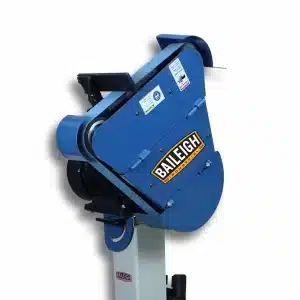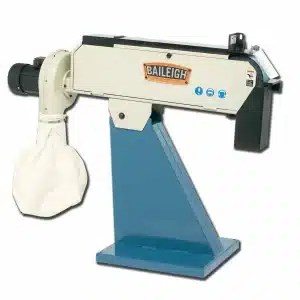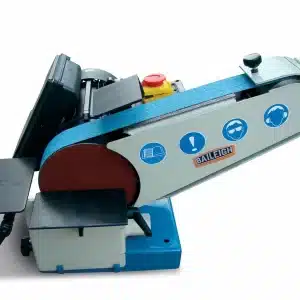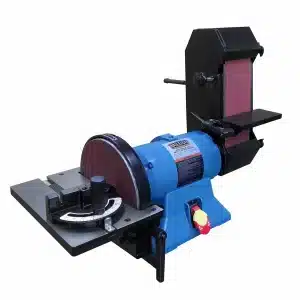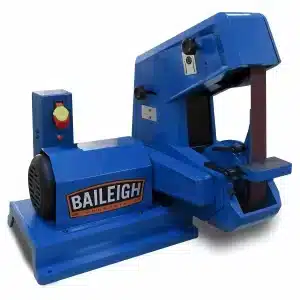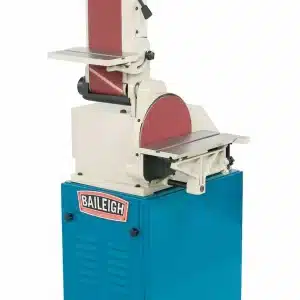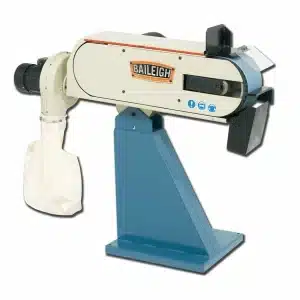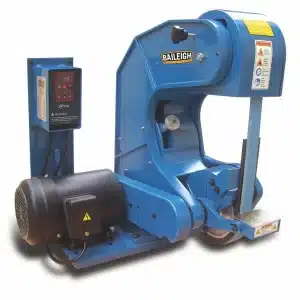Introduction To Disc & Belt Grinders
What Is a Disc & Belt Grinder?
A disc and belt grinder is a machine equipped with two abrasive surfaces: A flat disc and an endless belt that runs over two rollers. The disc is primarily used for shaping and grinding flat surfaces, while the belt is ideal for contouring and removing material.
Common Uses
- Metalworking: Deburring, shaping, grinding, and polishing metal parts
- Woodworking: Shaping wood, removing material, and preparing surfaces for finishing
- Tool sharpening: Sharpening chisels, plane blades, and other tools
Key Features of Onix’s Disc & Belt Grinders
Disc and belt grinders are indispensable due to their versatility and efficiency. They offer:
- Time savings: Quickly remove material and shape parts
- Precision: Achieve accurate and consistent results
- Surface finish: Create various finishes from rough to fine
- Cost-effectiveness: Reduce labor costs and material waste
By combining the functions of two essential tools into one machine, disc and belt grinders provide a valuable asset to any workshop.
Baileigh Industrial Disc & Belt Grinders
- Known for: Durability, versatility, and ease of use
- Features: Often include heavy-duty motors, adjustable work tables, and multiple speed settings
- Target market: Hobbyists, small shops, and light industrial use
Powermatic Disc & Belt Grinders
- Known for: Precision, power, and professional-grade build quality
- Features: Typically offer larger work surfaces, variable speed control, and dust collection systems
- Target market: Professional woodworkers, metalworkers, and industrial applications
Note: Both companies offer a range of models, from benchtop to floor-standing, so it’s essential to specify your needs before making a purchase.
Key Features To Consider When Comparing
When comparing disc and belt grinders from different manufacturers, consider the following:
- Motor power: Determines the machine’s ability to handle different materials and workloads
- Belt and disc size: Affect the range of materials and projects you can handle
- Work table size: This impacts the size of the workpiece you can accommodate
- Speed range: Allows you to adjust the speed for different materials and applications
- Dust collection: Essential for maintaining a clean workspace and operator health
- Safety features: Includes emergency stops, safety guards, and other protective measures
By carefully considering these features, you can select a disc and belt grinder that best suits your specific requirements.
Tips For Maintaining Your Disc & Belt Grinder
Proper maintenance is essential for the longevity and performance of your disc and belt grinder. Here are some practical tips:
Regular Cleaning and Inspection
- Dust removal: Regularly clean the grinder, especially the motor, belt path, and disc guard to prevent overheating and damage. Compressed air can be helpful.
- Belt alignment: Ensure the belt is properly aligned and tracking straight to prevent premature wear and uneven grinding.
- Disc condition: Check the disc for cracks, warping, or excessive wear. Replace it if necessary.
- Bearing lubrication: Lubricate bearings according to the manufacturer’s recommendations.
Belt and Disc Care
- Belt tension: Maintain proper belt tension to prevent slippage and premature wear.
- Disc replacement: Replace worn or damaged discs promptly.
- Abrasive selection: Choose the appropriate abrasive for the material you’re working with.
Safety Precautions
- Guard placement: Ensure all guards are in place and securely fastened.
- Eye and ear protection: Wear appropriate safety gear when operating the grinder.
- Workpiece support: Use a work rest to support your workpiece and prevent kickback.
Additional Tips
- Motor overload: Avoid overloading the motor by applying excessive pressure.
- Coolant use: For metalworking, consider using coolant to reduce heat and improve grinding performance.
- Storage: Store the grinder in a dry, dust-free environment.
For Professionals:
- Regular maintenance schedule: Implement a routine maintenance schedule to track inspections and repairs.
- Operator training: Ensure operators are properly trained in safe operation and maintenance.
- Calibration: Regularly calibrate the grinder for precision work.
For DIY Enthusiasts:
- Basic maintenance: Focus on regular cleaning, belt alignment, and disc replacement.
- Seek professional help: For complex issues, consult a repair technician.
- Follow manufacturer’s guidelines: Refer to the owner’s manual for specific maintenance instructions.
By following these guidelines, you can significantly extend the life of your disc and belt grinder and ensure optimal performance for years to come.

